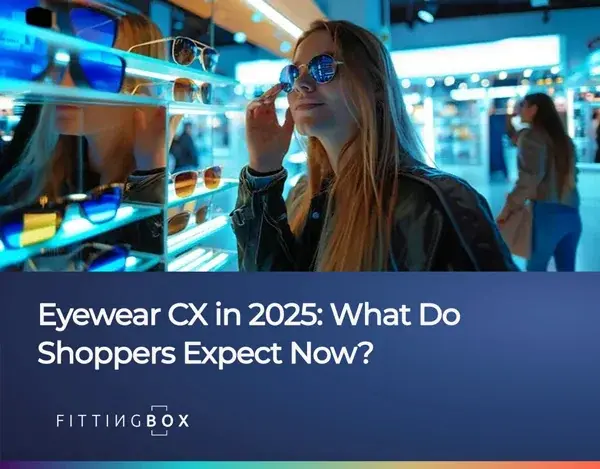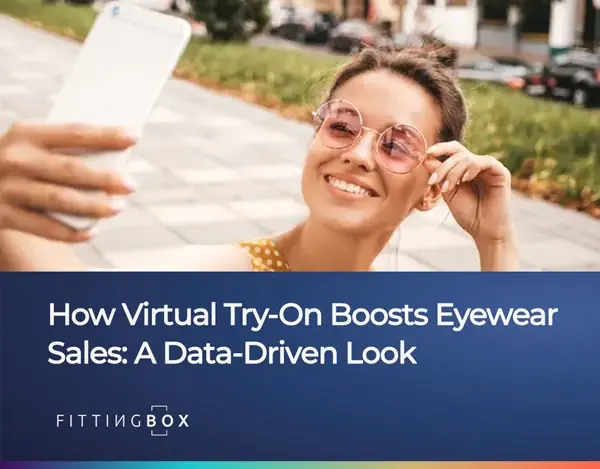
From Click to Conversion: What’s Working in Eyewear in 2025
In 2025, selling eyewear online is no longer just about attracting clicks, it's about turning those clicks into confident buyers. As consumer expectations evolve, optical retailers must rethink every step of the online journey to improve engagement, trust, and ultimately, conversions.
From personalized virtual fittings to data-enhanced product experiences, the eyewear industry is leaning into innovation. This article explores the proven strategies and emerging tools that help eyewear brands maximize their conversion rates this year.
🔑 Key Takeaways
-
Create a seamless and reassuring digital experience, especially when over 70% of users abandon carts due to unclear visuals or sizing.
-
Virtual try-on significantly boosts confidence, driving up to 42% higher conversion rates.
-
3D product views and guided descriptions enhance engagement and reduce decision friction.
-
Real-time data and A/B testing help optimize user journeys, with interactive elements lifting conversions by 25%.
-
Retailers that personalize and iterate continuously are setting a new standard in eyewear e-commerce.
-1.webp?width=700&height=467&name=woman-sitting-floor-while-making-new-purchase%20(1)-1.webp)
Understanding the Eyewear Consumer Journey in 2025
Eyewear shoppers in 2025 expect a seamless and reassuring digital experience. They seek efficiency, accuracy, and confidence when buying glasses online, especially for products that affect vision and personal appearance. This transformation in user expectations pushes retailers to refine every touchpoint of the digital buying journey.
Recent studies show that more than 70% of online eyewear buyers abandon their cart due to unclear sizing, poor visuals, or lack of confidence in product fit. These issues highlight the friction points that still exist in many online stores: limited product representation, generic user paths, and lack of guidance through complex choices like lens type or frame size.
To address this, eyewear retailers are mapping out consumer journeys more precisely than ever. They focus on micro-moments, when a user doubts, compares, or considers abandoning, and implement interactive elements to retain attention. For example, clear CTAs, smart filters, and contextual assistance can reduce bounce rates and keep users moving through the purchase funnel.
In 2025, your ability to increase conversions begins with understanding exactly where, when, and why your customers hesitate, and turning those friction points into seamless steps forward.
Personalization and Virtual Tools That Convert
In the eyewear market, personalization has become a key conversion driver. Consumers are drawn to experiences that reflect their unique face shape, vision needs, and style preferences. In 2025, digital tools make it possible to tailor the buying experience with precision, and these tools directly influence purchase decisions.
Among the most impactful innovations is the ability to try on eyewear virtually using real-time face tracking. Solutions like virtual try-on allow users to see how a frame fits their own face from multiple angles, increasing confidence and reducing returns. Data from the industry shows that virtual try-oneatures can increase conversion rates by up to 42% on product pages.
Other tools such as pupillary distance measurement and lens simulation ensure that functional accuracy complements visual aesthetics. A PD measure tool simplifies an often confusing step, while lens color simulator let users preview how their lenses will behave in different lighting conditions or prescriptions. These features remove uncertainty from the buying process, a major factor in cart abandonment.
Personalization extends beyond visuals. Behavioral data can dynamically adjust product recommendations and interface elements in real time. In 2025, eyewear retailers that leverage both interactive tools and intelligent personalization engines are setting new benchmarks for online conversions.
Optimizing the Product Experience for Higher Engagement
A polished, intuitive product experience is essential to keep users engaged and moving toward purchase. In eyewear e-commerce, this means making frames and lenses not only visible, but vivid and ensuring that every product detail is clear and accessible.
Advanced 3D viewers now allow shoppers to rotate frames, zoom in, and observe textures and hinges in photorealistic detail. This level of interactivity helps replicate the tactile experience of trying on glasses in-store. According to a 2024 market report, 3D product visualization can increase user time on page by over 30% and reduce product-related doubts significantly.
Removing distractions is just as important. Frame removal features, which digitally erase existing eyewear from a user’s face before trying on new frames virtually, offer a cleaner, more accurate view. This increases engagement and ensures a better perception of fit and style.
Beyond visuals, retailers must ensure that product descriptions are concise yet comprehensive. Information on materials, frame sizes, lens compatibility, and user reviews should be easily accessible. Adding contextual guidance, like “best for oval faces” or “ideal for progressive lenses”, helps users make faster and more informed decisions.
An optimized product experience builds trust and clarity, allowing customers to focus on what matters most: choosing eyewear that suits their look and lifestyle.
.webp?width=700&height=467&name=beautiful-young-woman-using-her-mobile-phone-office%20(1).webp)
Data-Driven Strategies to Boost Conversion Rates
In 2025, data is not just for analysis, it is a tool for action. Eyewear retailers increasingly rely on real-time insights and predictive modeling to enhance the shopping experience and optimize conversion rates.
Behavioral analytics tools can reveal key patterns: where users drop off, which filters they use most, and how product positioning impacts click-throughs. Retailers who apply these insights through A/B testing see tangible results. For example, replacing static images with interactive modules led to a 25% boost in completed purchases in one major eyewear store.
Heatmaps and scroll tracking also allow brands to redesign pages based on user flow, ensuring that key product features and CTAs are never buried. Coupled with AI-driven recommendations, retailers can present users with frames they are more likely to buy, based on face shape, preferences, or purchase history.
Importantly, successful strategies are no longer one-size-fits-all. Segmentation by user intent, location, or even device type allows for experiences tailored to each segment. Whether showing virtual try-on earlier in the journey or emphasizing prescription support for return visitors, adapting based on data improves both usability and performance.
The eyewear brands that lead in 2025 are those that test, learn, and iterate constantly, using real user data as the foundation of their growth strategy.
Conclusion
To succeed in eyewear e-commerce in 2025, your strategy must go beyond traffic generation. It’s about transforming interest into confident action. That means understanding user behavior in depth, leveraging interactive and personalized tools, optimizing every element of the product experience, and using data to guide continuous improvements.
The retailers that embrace these conversion-focused approaches are the ones turning browsers into loyal customers and setting new standards in the eyewear industry.
LET'S TALK
Request a demo, a quote or set up an appointment with one of our sales representatives.
CONTACT USUseful Links
Corporate
© FITTINGBOX 2025 • Terms of use • Privacy & Legal



